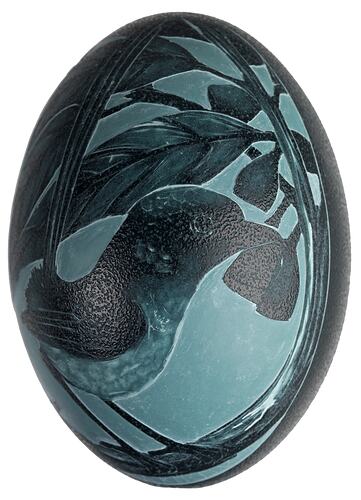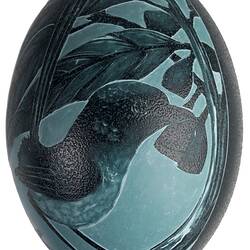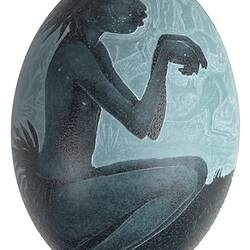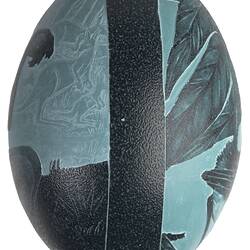Summary
'I have been carving emu eggs since 1977' says renowned carver Esther Kirby. 'The knowledge was passed down by my father Sam Kirby, 'the Boss Carver', up until he passed away.'
A Barrapparra Elder, Aunty Esther Kirby is also a descendent of the Wiradjuri, Yitta Yitta, Narre, Yorta Yorta and Wemba Wemba peoples. Aunty Esther was born on her traditional lands at the Balranald Mission in 1950, where she lived until she was 14. Her father Sam Kirby was well known for his fine egg carvings, and his masterful skill and ability 'to do anything with the eggs'. Aunty Esther watched Sam work and learnt all his techniques. After her father passed away in 1977, she began carving to keep his name going.
In the late 1980s Esther began to paint images of local traditional stories, and she continues to use materials from the land - eggs, wood and emu leather to create works that reflect a lifelong journey of learning. A respected Elder of her community, she was committed to ensuring Koori culture survives and strengthens.
'This egg with a Blue Wren on one side and kangaroos on the other was carved down through the 15 layers of shell to produce the lightest shaded sections. If I can see the picture in there, I just go with it. Once I start I'm focused, and I can sit there for most of the day.' 'The Blue Wren is a harmony bird,' Esther says, 'bringing good luck.'
Aunty Esther Kirby sadly passed away in Nov 2022.
Physical Description
Emu egg, incised, depicting two scenes. Scene a: Foreground - boy/dancer in crouched dance position, background scene of seven kangaroos in a wooded landscape. Scene b: Foreground - willy wagtail perched on a branch with vegetation - leaves and gum nuts. The artist has etched her name at the bottom of the willy wagtail scene. Holes at top and bottom.
Significance
Aunty Esther Kirby shares some knowledge about the fine art of emu egg carving and speaks of how she began her beautiful carving work;
'The emu egg was my father's trade that he learned off his uncle. They'd carve with a pocket knife and a little three-quarter file. Sometimes when they didn't have a pocket knife they'd carve with glass or sharpen a jam tin. His uncle Joe Walsh, he was a beautiful carver. Both of them two old fellas, as far as I'm concerned they're the top artists. When I started carving is when my father passed away. None of the boys took it up so I took it up. So I carved a couple of eggs, because dad had some eggs that people had paid for and he didn't deliver the eggs so I finished the eggs. I was basically doing it for my father's sake, keep my father's name going in the art world. And then it changed over to doing it for myself and my children. My carving knife is like a scalpel. I use two different files, an eight inch file and a six inch file. There's about 13 to 15 different shades in the egg from the outer layer down to the white. The white one is about the thickness of two cigarette papers. When you've finished, you wrap it up and put it away and don't touch it til you sell it.' Aunty Esther Kirby, 2013.
More Information
-
Object/Medium
Carving
-
Maker
-
Locality
-
Date Produced
-
Fully Extended
100 mm (Width), 135 mm (Height)
-
Classification
-
Date Made
-
Maker
-
Clan/Language Group
-
Place Made
-
Indigenous Region
-
Keywords
-
Type of item
-
Discipline
-
Category
-
Collecting Areas



